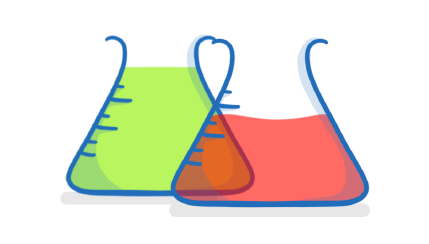Test for Anions
This lesson covers:
- How to test for carbonate ions (CO32-), using hydrochloric acid and limewater
- How to test for sulfate ions (SO42-) using hydrochloric acid and barium chloride
- How to test for halide ions (Cl-. Br-, I-), using nitric acid and silver nitrate
The term 'anion' just means a negatively charged ion. For example, Cl-, SO42-, and CO32- ions are all anions.
How to test for carbonate ions:
green / cloudy / hydrochloric / dioxide / limewater
- React the substance with acid (HCl).
- If the substance contains a carbonate ion, carbon gas will bubble out of the solution.
- Collect the gas and bubble it through .
- If the limewater turns , it confirms the gas is carbon dioxide.
- Confirmation that the gas is carbon dioxide is confirmation that the original substance contained carbonate ions.
|
A chemical reaction is taking place in a test tube. What methods could be used to collect the gas?
(Select all that apply)
Place an upside down measuring cylinder over the test tube to trap the gas
Attach the top of the test tube to a gas syringe
Place the reaction beaker on a set of scales
|
How to test for sulfate ions:
sodium / barium / white / blue / hydrochloric / sulfate
- React the substance with acid (HCl) to remove any carbonate ions.
- Add chloride solution.
- If ions are present, it will form a precipitate of barium sulfate.
|
When testing for sulfate ions, why do we have have to add hydrochloric acid first?
To make the solution more acidic
To turn the sulfate ions to sulfide ions
To react with any carbonate ion impurities
|
How to test for halide ions:
iodide / chloride / bromide / silver / nitric
- React the solution with acid to remove any carbonate ions or sulfite ions.
- Add nitrate solution.
- If a white precipitate forms, the substance contains ions.
- If a cream precipitate forms, the substance contains ions.
- If a yellow precipitate forms, the substance contains iodide ions.
|
An unknown solution is mixed with nitric acid, and then silver nitrate. A cream precipitate forms.
Which anion did the solution contain?
Iodide ions
Chloride ions
Bromide ions
|

When testing for halide ions, is nitric acid or hydrochloric acid used?
Nitric acid
Hydrochloric acid
|
An unknown solution is mixed with hydrochloric acid and then barium chloride. A white precipitate forms.
Which anion did the solution contain?
Chloride ions
Sulfate ions
Carbonate ions
Bromide ions
|
An unknown solution is mixed with hydrochloric acid and bubbles of gas are given off. The gas is bubbled through limewater and the limewater turns cloudy.
Which anion did the solution contain?
Chloride ions
Sulfate ions
Bromide ions
Carbonate ions
|
An unknown solution is mixed with nitric acid and then silver nitrate. A white precipitate forms.
Which anion did the solution contain?
Chloride ions
Carbonate ions
Bromide ions
Sulfate ions
|